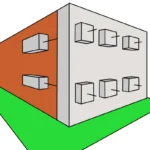Rigid pavement is a paving infrastructure designed to provide a strong, resilient, and durable surface for roads, streets, airports, ports, and other areas with heavy traffic. It is characterized by its load-bearing capacity and rigidity, meaning it has low deformation under applied loads and effectively distributes those loads across its surface.
The distinctive feature of rigid pavement is its construction using reinforced concrete slabs, which are flat, rectangular pieces of concrete specifically designed to withstand traffic stresses and climatic variations. These slabs are typically rectangular and arranged in a pattern, with planned expansion and contraction joints to accommodate thermal expansion and contraction of concrete due to temperature changes. These joints also help prevent the formation of uncontrolled cracks.
Layers of Rigid Pavement
Rigid pavement consists of several layers working together to provide a durable and resilient surface. These layers, arranged in descending order from the pavement surface, are as follows:
1. Surface Layer (Concrete Slabs):

This is the top layer of rigid pavement and the one in direct contact with traffic. It consists of reinforced concrete slabs designed and constructed to bear vehicle loads and provide a uniform, wear-resistant surface. Concrete slabs typically have varying thicknesses depending on the application and the expected traffic. These slabs are placed in patterns that include expansion and contraction joints to allow for thermal expansion and contraction of concrete, thus preventing the formation of uncontrolled cracks.
Here are some key aspects of concrete slabs:
Materials Used: Concrete slabs are primarily manufactured using Portland cement, aggregates (such as sand, gravel, or crushed stone), and water. These materials are mixed in specific proportions to achieve the required strength and durability. Additionally, steel reinforcements, such as bars or meshes, may be incorporated to enhance concrete flexural strength and resistance to cracking.
Thickness: The thickness of concrete slabs varies depending on the application and anticipated traffic. In high-speed roads and airports, slabs are often thicker to support heavier loads. Typical thickness for road concrete slabs may range from 8 to 12 inches (20 to 30 centimeters) or more.
Expansion and Contraction Joints: To allow for thermal expansion and contraction of concrete due to temperature changes, expansion and contraction joints are planned in the slabs. These joints are essential to prevent the formation of uncontrolled cracks on the pavement surface.
Surface Finish: The surface of concrete slabs can be finished in different ways, depending on specific requirements. The finish can be rough for better traction or polished for enhanced appearance and driving comfort.
Concrete Quality: Concrete quality is crucial for pavement durability. The concrete must meet certain standards of strength, density, and durability to ensure performance over time.
2. Aggregate Base:
Just below the concrete slabs is the aggregate base layer. Its main function is to provide a uniform and stable support surface for the concrete slabs. This layer helps evenly distribute traffic loads and prevent deformation of the underlying soil.
Materials Used: Materials used in the aggregate base layer vary depending on local conditions and project specifications but typically include:
Gravel: Gravel is a granular material commonly used in the aggregate base. It provides excellent drainage capacity and compression resistance. Quality and gradation of gravel are critical factors for ensuring good base performance.
Crushed Stone: Crushed stone is another widely used granular material. It is obtained by crushing large rocks into specific sizes. Like gravel, crushed stone offers good strength and drainage capacity.
Sand: Sand is a finer material that can be used in the mix to help fill the spaces between larger gravel or crushed stone particles. This can improve compaction and stability of the base.
Recycled Materials: In some cases, recycled materials such as recycled concrete or asphalt can be used in the aggregate base, as long as they meet the necessary quality and strength requirements. Material recycling can be a sustainable option.
Thickness and Gradation: The thickness of the aggregate base layer varies depending on pavement design and site conditions but typically falls in the range of 6 to 12 inches (15 to 30 centimeters) or more. Material gradation, i.e., the distribution of particle sizes, is carefully controlled to ensure proper compaction and good drainage capacity. Proper gradation is essential to prevent settling and cracking of the pavement.
Compaction: Compacting the aggregate base layer is a critical step in pavement construction. Heavy equipment, such as roller compactors, is used to compact the materials and increase their density. Proper compaction ensures that the base is stable and can support traffic loads without excessive deformation.
3. Subbase:
The subbase is the deepest layer of rigid pavement and is placed directly over the natural soil or foundation ground. Its main function is to improve pavement drainage and provide additional support to the aggregate base. The subbase generally consists of granular materials, such as gravel or crushed stone, and its thickness varies depending on local conditions and project requirements.
Materials Used: Common materials used in the subbase layer may include:
Gravel or Crushed Stone: Similar to the aggregate base layer, gravel and crushed stone are frequently used in the subbase. They provide good drainage capacity and compression resistance. The selection of material type and size depends on local conditions and project requirements.
Sand: While less common in the subbase compared to the aggregate base, sand can be used to improve compaction and drainage capacity. Finer sand can fill the spaces between larger particles, enhancing stability.
Recycled Materials: In certain projects, recycled materials such as recycled concrete or asphalt may be used in the subbase, provided they meet quality and strength standards. This can be a sustainable and cost-effective option.
Thickness and Gradation: The thickness of the subbase layer varies based on pavement design and site conditions but typically falls in the range of 4 to 12 inches (10 to 30 centimeters) or more. Material gradation is carefully controlled to ensure good drainage capacity and uniform load distribution.
Compaction: Proper compaction of the subbase layer is essential to ensure its stability. Heavy equipment, such as roller compactors, is used to compact the materials and increase their density. Well-compacted subbase provides solid support for the aggregate base and concrete slabs.
4. Foundation Soil:
This is the deepest layer and is composed of natural soil or the ground upon which rigid pavement will be constructed. The quality and load-bearing capacity of the foundation soil are critical for pavement durability and stability. In some cases, it may be necessary to improve or reinforce the foundation soil before pavement construction.
Materials Used: Materials in the foundation soil are the natural soil or ground upon which the rigid pavement will be constructed. Unlike the upper layers of pavement, intentional addition of different materials is not made. Types of soil used can vary widely based on geographic location and local conditions but often include:
Native Soil: The existing natural soil on the site, which can range from clay to silt, sand, gravel, or a combination of these. The quality and load-bearing capacity of native soil are critical factors in pavement design.
Improved Soil: In some cases, it may be necessary to improve or reinforce the foundation soil to increase its load-bearing capacity or enhance drainage. This can be achieved through soil stabilization techniques, such as adding lime, cement, or other materials.
Foundation Soil Characteristics: The quality and characteristics of the foundation soil are crucial for rigid
pavement performance. Key aspects to consider include:
Load-Bearing Capacity: The foundation soil’s capacity to support traffic loads is a critical factor. Engineering analysis is performed to determine if the existing foundation soil meets pavement load-bearing capacity requirements.
Compaction: Proper compaction of the foundation soil is essential to prevent settlement and deformation of the pavement. Compaction is carried out using heavy construction equipment, such as roller compactors.
Drainage: Foundation soil drainage is important to avoid water-related issues such as erosion and soil softening. Adequate drainage is achieved through proper design of drainage systems, such as drainage ditches, pipes, and granular material.
It is important to note that, in addition to these main layers, there may be additional layers in certain rigid pavement designs, such as a separation layer to prevent fines migration from the foundation soil to upper layers or a drainage layer to manage water flow.
Steps for Rigid Pavement Calculation
Calculating rigid pavement involves a series of steps and design methods to ensure that the structure can withstand traffic loads and environmental conditions throughout its lifespan.
Traffic Load Determination: The first step is to estimate the loads that the pavement will need to bear over its lifespan. This involves considering the type, quantity, and frequency of vehicles that will travel the road, including light vehicles, trucks, buses, etc. Traffic formulas or vehicle count data are used for these estimates.
Selection of Concrete Slab Thickness: The thickness of concrete slabs is a critical consideration in rigid pavement design. A structural design method is used that takes into account traffic loads, concrete strength, foundation soil load-bearing capacity, and other factors. One of the most commonly used methods is the AASHTO (American Association of State Highway and Transportation Officials) method for rigid pavement design.
Joint Analysis: Expansion and contraction joints are integral parts of rigid pavements to allow for thermal expansion and contraction of concrete. The design of these joints and their location is based on calculations considering local climatic conditions and the type of concrete used.
Assessment of Foundation Soil Load-Bearing Capacity: It is important to determine the load-bearing capacity of the foundation soil upon which the pavement will be constructed. This is done through geotechnical tests that assess the strength and compressibility of the soil. If necessary, soil improvements may be carried out to increase load-bearing capacity.
Drainage and Subbase Design: Proper drainage is essential for the lifespan of rigid pavement. The drainage system that effectively removes water away from the pavement is calculated. Additionally, the subbase layer is designed to provide a stable and uniform base.
Crack Control: Design methods and construction details are employed to control the formation of cracks in the concrete. This includes the use of reinforcements, joints, and appropriate curing techniques.
Life Cycle Analysis and Maintenance: A life cycle analysis is conducted to determine how long the rigid pavement is expected to fulfill its function without major maintenance. This helps plan for future maintenance and repairs.
Cost Evaluation: Costs associated with the construction and maintenance of rigid pavement are assessed to make informed decisions about investing in road infrastructure.
These are the general steps involved in the calculation and design of rigid pavement. It is important to note that specific methods and standards may vary by region and local regulations, so consulting applicable regulations and design guidelines for your particular location is essential. Additionally, pavement design software is often used to facilitate calculations and analyses.

Applications of Rigid Pavement
Rigid pavement is used in a wide variety of places and applications due to its ability to withstand heavy loads and its durability. Here is a list of common places where rigid pavement is used:
Roads and Highways: Rigid pavement is widely used on roads and highways worldwide due to its ability to withstand heavy traffic loads and its resistance to abrasion and wear.
Airports: In airport runways and taxiways, rigid pavement is essential due to its ability to support the weight of large and heavy aircraft, as well as to provide a smooth and wear-resistant surface.
Ports and Maritime Terminals: In loading and unloading areas of ports and maritime terminals, rigid pavement is necessary to support the loads of cargo handling equipment and heavy-duty trucks.
Parking Lots: Intensively used parking lots, such as those at shopping malls, hospitals, and airports, are often paved with concrete due to its traffic resistance and durability.
Rural Roads: In rural and agricultural areas, rigid pavement is used on roads and highways to withstand agricultural traffic and provide reliable access to farms.
Bridges: Rigid pavement is used on bridge decks to provide a durable and resistant driving surface.
Pedestrian Walkways and Bike Paths: In urban areas, rigid pavement is used on pedestrian walkways and bike paths to resist wear caused by pedestrians and bicycles.
Industrial Areas: In industrial facilities, such as factories and production plants, rigid pavement is used to support loads from heavy equipment and machinery.
Sports Facilities: In tennis courts, skating rinks, and other outdoor sports facilities, rigid pavement is used to provide a durable playing surface.
Loading and Storage Areas: In warehouses and distribution centers, rigid pavement is essential to support loads from forklifts and heavy vehicle traffic.
Conclusion
Rigid pavement is a paving infrastructure designed to offer a strong, resilient, and durable surface in a variety of applications, from roads and airports to parking lots and industrial areas. Its distinctive feature lies in the construction using reinforced concrete slabs, designed to withstand heavy traffic loads and adapt to climatic conditions through expansion and contraction joints. The design process involves carefully considering factors such as traffic load, slab thickness, joint analysis, foundation soil load-bearing capacity, drainage, and crack control. Additionally, rigid pavement is used in a wide range of places due to its ability to resist heavy loads and its durability, from roads and airports to industrial and sports areas. Its versatility and ability to provide reliable surfaces make rigid pavement essential in the construction and maintenance of road infrastructure and other key applications worldwide.







Related
Flexible Pavement vs. Rigid Pavement: What’s the Difference?
What is Flexible Pavement?
What is Steel Fiber Concrete in Pavements?